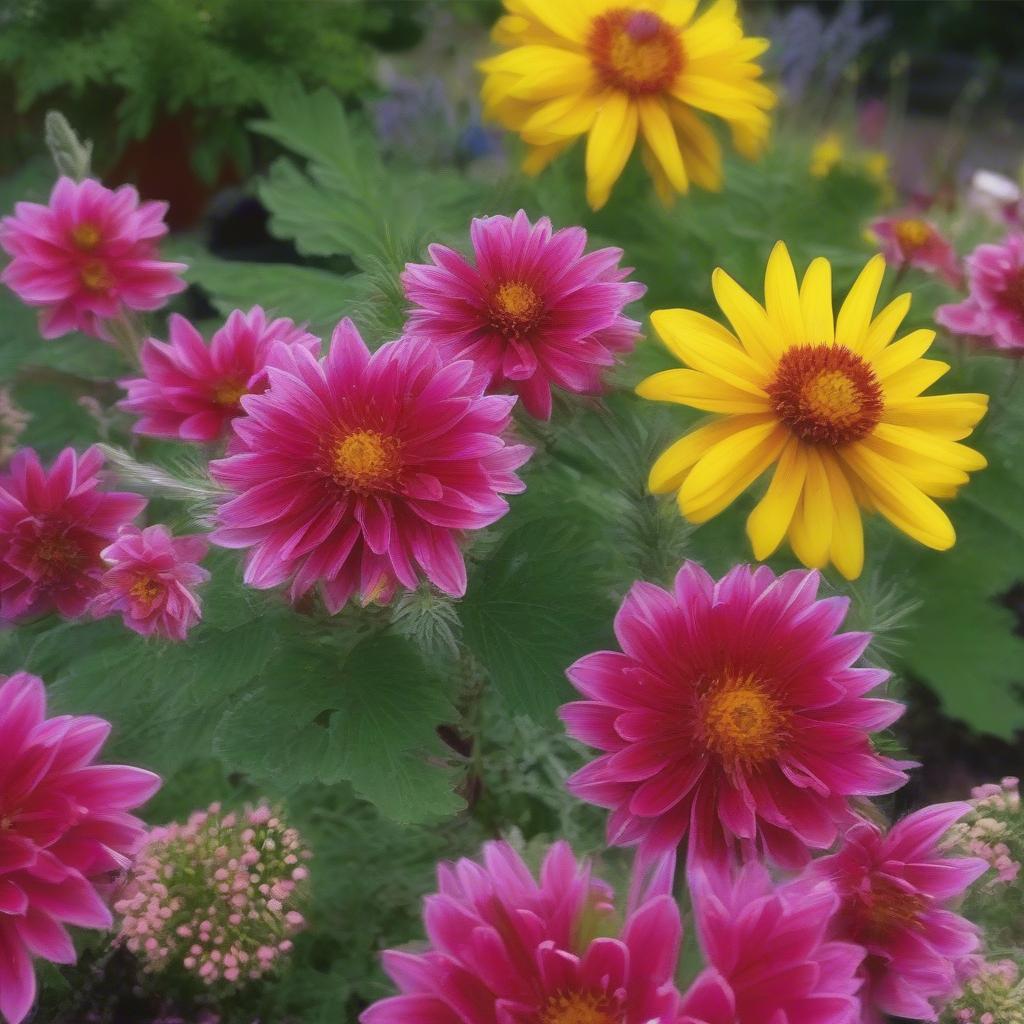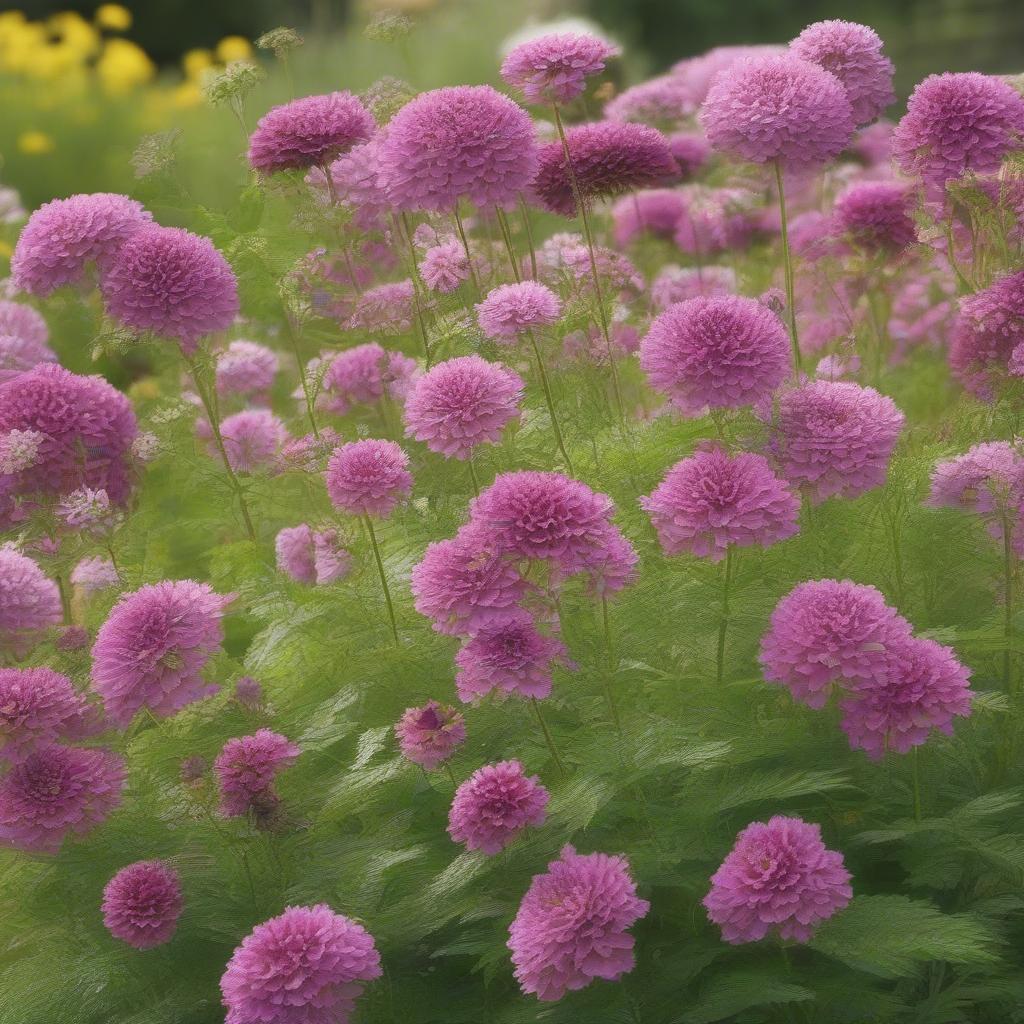
A Complete Guide to Perennials
Perennials are the stalwarts of our garden borders, providing colorful garden flowers year after year. With many different types to choose from, including herbaceous perennials, short-lived perennials, woody perennials, and hardy perennials, there’s a perennial to suit every type of garden.
What’s the difference between annual and perennial?
Most garden plants are either annual or perennial. Annual plants flower, set seed, and die within 12 months, while perennials live for several years. Perennials are split into further categories:
*
- Herbaceous perennials: These die back to the ground in autumn and regrow in spring. Examples include Verbena bonariensis, penstemon, and ornamental poppies.
- Evergreen perennials: These keep their leaves all year round, such as some varieties of heuchera and hosta.
- Woody perennials: While most shrubs are referred to as shrubs, some smaller-growing perennials that develop woody stems are described as shrubby or woody perennials. These include lavender and some salvias.
- Hardy perennials: Hardy plants tolerate low temperatures and can be planted outside all year long. Many of them are herbaceous and die back each autumn, such as cranesbill geraniums and phlox. Some are evergreen and/or shrubby, such as lungwort and lavender.
- Half-hardy perennials: Half-hardy perennials are tolerant of winter wet and cold, but are vulnerable to frost. They therefore need protection over winter such as a thick mulch of straw over the roots or can be dug up and brought into an unheated greenhouse for winter. Examples include penstemon and salvias.
- Tender perennials: These won’t survive winter wet or cold and need digging up in autumn and storing in a frost-free location. They include dahlias and gazanias.
Choosing Perennials for Your Garden
For the greatest success when growing perennials, choose the right plant for the right place. Assess your site, including soil type and how moisture-retentive it is, the amount of sun or shade the area gets, and how exposed it is to the wind. There are perennial plants for absolutely every situation, and matchmaking their growing preferences to your site means they should thrive for many years. Choose a selection that flowers at different times of the year and combine it with shrubs, ornamental grasses, and annuals for a long-lasting display.
20 Top Perennial Plants to Grow
1. Yarrow, Achillea
Yarrow is an herbaceous perennial that makes a colorful summer display in a sunny spot. It produces large, flat heads made up of many tiny flowers, borne on stems above clumps of feathery leaves which are green or silvery in color. Yellow varieties predominate, and there are reds and oranges too.
Height x Spread: 45-75cm x 45-60cm
Buy yarrow from Thompson & Morgan, Suttons, Primrose, or J Parkers.
2. Michaelmas Daisy, Aster
Michaelmas daisies or asters are an herbaceous stalwart of late summer and autumn borders. They bear masses of daisy flowers on sturdy stems in brilliant pinks, mauves, purples, and white. They are also excellent plants for pollinating insects. They prefer sun.
Height x Spread: 30-75cm x 45cm
Buy Michaelmas daisy from Thompson & Morgan, Suttons, or J Parkers.
3. Elephants Ears, Bergenia
Bergenia is a tough perennial that makes excellent ground cover in sun or shade and thrives on any reasonable soil. In late winter and early spring, large clusters of pink, white, or purple flowers are borne.
Height x Spread: 30-45cm x 45-75cm
Buy elephants ears from Thompson & Morgan, Suttons, Van Meuwen, or J Parkers.
4. Crocosmia
Crocosmia is a herbaceous perennial growing from bulb-like corms. Crocosmias are also known as montbretia, although this tends to refer to the common species Crocosmia x crocosmiiflora. This has naturalized in many areas and is considered to be invasive. It is listed on Schedule 9 of the Wildlife and Countryside Act in England and Wales, meaning it is an offense to plant or otherwise cause to grow this species in the wild.
Height x Spread: 60-90cm x 30-40cm
Buy crocosmia from Thompson & Morgan, Suttons, Van Meuwen, or J Parkers.
5. Delphinium
Delphinium bears tall stems clothed with many strikingly beautiful flowers, which open over time from bottom to top, so the plant gives color for many weeks. Blue is the predominant shade, as well as white, pink, and mauve.
Height x Spread: 60-90cm x 30-45cm
Buy delphinium from Thompson & Morgan, Suttons, Van Meuwen, or J Parkers.
6. Sea Holly, Eryngium
Sea holly combines handsome, often architecturally shaped or variegated leaves with tall stems of blue flowers in summer that are beloved by bees. It prefers sun and free-draining soil and is ideal in gravel gardens, too.
Height x Spread: 45-60 m x 30-45cm
Buy eryngium from Thompson & Morgan, Suttons, Primrose, or J Parkers.
7. Spurge, Euphorbia
Euphorbias give long-lasting interest with a combination of attractive, architectural foliage and bold heads of flowers in colors such as lime, yellow, and orange-red. These are papery bracts, not flowers, which is why they last for months rather than weeks. Many varieties keep their foliage and form through winter.
Height x Spread: 15-120cm x 45-120cm
Buy euphorbia from Thompson & Morgan, Suttons, or J Parkers.
8. Cranesbill, Geranium
Geranium is an extensive and varied group of plants that are superb for border fronts, raised beds, and underplanting larger plants. Most flower in summer, and the length of the flowering period varies hugely. Rozanne is an outstanding variety that blooms for many months.
Height x Spread: 30-90cm x 30-90cm
Buy geraniums from Thompson & Morgan, Suttons, or J Parkers.
9. Hellebores, Helleborus
Hellebores are winter-spring-flowering perennials, including Christmas rose Helleborus niger and Lenten rose Helleborus orientalis. Attractive foliage is mostly evergreen, and pretty flowers range in color from white and green to shades of pink and purple.
Height x Spread: 30-50 cm x 30-40cm
Buy hellebores from Thompson & Morgan, Suttons, Van Meuwen, or J Parkers.
10. Daylilies, Hemerocallis
Daylilies have colorful, lily-like open trumpet blooms borne in clusters on sturdy stems. The individual blooms last only for a day, hence the name, but are produced in profusion to give a good display over a number of weeks in summer.
Height x Spread: 30-60 cm x 45-60cm
Buy daylilies from Thompson & Morgan, Suttons, Van Meuwen, or J Parkers.
11. Heuchera
Heucheras are renowned for their all-year foliage interest. They have scalloped-edged leaves in neat clumps and an exceptional choice of colors, including lime-green, yellow, purple, and orange.
Height x Spread: 30-45cm x 30-45cm
Buy heucheras from Thompson & Morgan, Suttons, Primrose, or J Parkers.
12. Hosta
Hostas are grown mainly for their bold and handsome leaves in many subtle variations including greens, glaucous blue, and variegated with white or yellow markings.
Height x Spread: 30-75 cm x 30-75 cm
Buy hostas from Thompson & Morgan, Suttons, Van Meuwen, or J Parkers.
13. Ice Plant, Hylotelephium spectabile
Ice plant provides color in late summer and is attractive to bees and butterflies. It bears large, flat heads composed of many tiny blooms in shades of pink and red.
Height x Spread: 30-45 cm x 30-45 cm
Buy ice plant from Thompson & Morgan, Suttons, or J Parkers.
14. Iris
Iris is a huge genus with species and varieties that offer something for almost every garden situation. Moisture-loving species thrive in boggy soil and at the pond edge, dwarf iris are good in rockeries and raised beds, and sumptuous-flowering bearded iris must have full sun and well-drained soil.
Height x Spread: 15-90cm x 20-60cm
Buy iris from Thompson & Morgan, Suttons, Van Meuwen, or J Parkers.
15. Japanese Anemone, Anemone hupehensis
Japanese anemone is easy and reliable for late summer flowers, bearing tall stems of saucer-shaped flowers in white and pink.
Height x Spread: 60-90cm x 45-60cm
Buy Japanese anemones from Thompson & Morgan, Suttons, or J Parkers.
16. Lupin
Lupin is an old favorite cottage garden flower. It is renowned for tall vertical flower spikes clad with many little, colorful blooms in summer above clumps of divided leaves.
Height x Spread: 45-90cm x 45cm
Buy lupins from Thompson & Morgan, Suttons, or J Parkers.
17. Bee Balm, Monarda
Bee balm bears flowers that are exceptionally rich in nectar, hence its name, as bees and other pollinating insects seem to love its blooms. This bold perennial forms good-sized clumps of sturdy stems topped with showy red or pink flowers in summer.
Height x Spread: 60-75cm x 1m
Buy monarda from Thompson & Morgan, Suttons, or J Parkers.
18. Oriental Poppy, Papaver orientale
Oriental poppies bear enormous, showy blooms in spring and early summer, followed by decorative seedheads. Colors include pink, red, coral, and white, mostly with contrasting black centers.
Height x Spread: 60cm x 45-60cm
Buy Papaver orientale from Thompson & Morgan, Suttons, Primrose, or J Parkers.
19. Primroses, Primula
Primroses are beloved for their early flowers – prima rosa is Latin for “first rose” – and our native primrose starts blooming in winter in mild areas.
Height x Spread: 15-60cm x 15-45 cm
Buy primroses from Thompson & Morgan, Suttons, or J Parkers.
20. Lungwort, Pulmonaria
Lungwort sparkles with color in spring and are both beautiful and useful, tolerating shade as well as sun and forming low-spreading clumps that can be planted beneath shrubs and trees.
Height x Spread: 30cm x 45 cm
Buy lungwort from Thompson & Morgan, Van Meuwen, or J Parkers.
When to Plant Perennials
Autumn is the ideal time to plant hardy perennials, while the soil is still warm, and plants can establish a good root system ready for the following spring.
After autumn, spring is the next best time to plant perennials, as long as plants are watered during dry spells when temperatures increase in summer.
You can plant perennials in summer, however, it’s critical that the plants are kept watered for the rest of the growing season, as there’s naturally less moisture in the soil.
Hardy perennials can be planted in mild areas during winter, except when the ground is frozen or waterlogged.
How to Plant Perennials
1. Prepare ground thoroughly, as some perennials will be there for years.
2. Improve the soil with plenty of well-rotted organic matter or soil conditioner, remove large stones, and clear all weeds, particularly the roots of perennial weeds.
3. Dig a hole slightly larger than the plant’s roots or pot.
4. Remove the pot and carefully unwind any roots that have spiraled around the rootball.
5. Put the perennial in the ground so the top of the rootball is at soil level.
6. Backfill with soil, firming it to remove any air pockets, and water thoroughly.
Caring for Perennials
1. Deadhead spent flowers to prolong the flowering season and to keep plants looking good.
2. In autumn, cut back fleshy-leaved perennials as soon as they die back, otherwise, the leaves go soggy and rot.
3. Wood-stemmed perennial growth can be left until late winter/spring before cutting back.
4. Tidy evergreen perennials from time to time to remove dead or tatty leaves and faded flower stems.
5. After three to five years, perennials tend to form large clumps and performance starts to decline. Lifting, dividing, and replanting them will rejuvenate plants and provide you with more plants to grow around the garden.
How to Propagate Perennials
Perennials are superb for the budget-conscious gardener. Many can be raised cheaply from seed. Once perennials have formed good-sized clumps, nearly all can be propagated by division, breaking up the clump into good-sized chunks to replant while discarding the old, woody center.
Advice on Buying Perennials
Perennials are widely available at nurseries and garden centers, usually in at least two different pot sizes, so you have the option of buying more costly plants for instant impact, or smaller ones that take a year or two to grow.
Perennials can also be bought by mail order – the best time to buy is autumn to spring, when plant growth is dormant, and they are more easily transported.
Bare-rooted plants are available while dormant, which avoids using plastic pots and is often cheaper.
Perennials can also be bought as plug plants, which are small and need growing on in pots before planting in the garden.
Where to Buy Perennials Online
1. Thompson & Morgan
2. Primrose
3. Suttons
Frequently Asked Questions
1. Do perennials come back every year?
Yes. Perennials are long-lived plants that return year after year, although short-lived perennials may return for just two to three years.
2. Does perennial mean evergreen?
No. Perennial means it comes back year after year. Some perennials are also evergreen, like hostas and some heucheras, but most perennials are herbaceous, meaning they die back each autumn and regrow in spring.
3. Is perennial permanent?
Sort of. Perennial plants come back year after year, but some are only short-lived, so they may last only for two to three years.
Frequently Asked Questions
Do perennials come back every year?
Yes. Perennials are long-lived plants that return year after year, although short-lived perennials may return for just two to three years.
Does perennial mean evergreen?
No. Perennial means it comes back year after year. Some perennials are also evergreen, like hostas and some heucheras, but most perennials are herbaceous, meaning they die back each autumn and regrow in spring.
Is perennial permanent?
Sort of. Perennial plants come back year after year, but some are only short-lived, so they may last only for two to three years.















